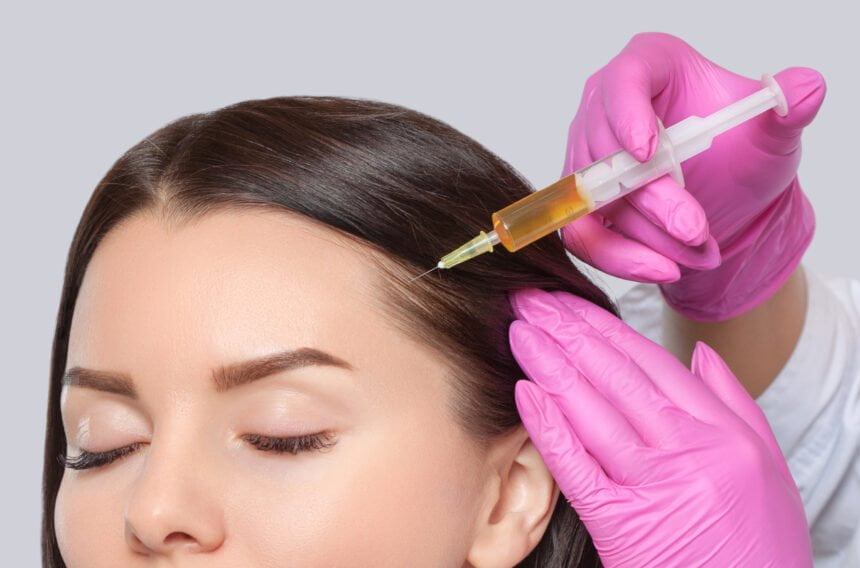Platelet-Rich Plasma (PRP) therapy has emerged as a versatile treatment option across various medical specialties, offering promising results in dermatology, orthopedics, and aesthetic medicine. This innovative approach harnesses the body’s natural healing mechanisms to address a wide range of conditions, from skin rejuvenation to tissue regeneration. In this article, we will delve into the diverse applications of PRP therapy, highlighting its specific benefits in each area of medicine and examining the scientific evidence supporting its effectiveness.
Dermatology:
In dermatology, PRP therapy has gained popularity as a non-invasive treatment option for various skin conditions, including acne scars, wrinkles, and hair loss. By isolating and concentrating platelets from the patient’s own blood, PRP injections stimulate collagen production and promote tissue regeneration, leading to improved skin texture and appearance. Clinical studies have demonstrated the efficacy of PRP therapy in reducing the visibility of acne scars and fine lines, as well as promoting hair growth in patients with alopecia. Moreover, PRP treatments are safe and well-tolerated, making them suitable for patients seeking natural-looking results without the need for surgery or downtime.
Applications of PRP Therapy in Dermatology:
- Acne Scars: PRP injections have been shown to improve the appearance of acne scars by promoting collagen production and tissue regeneration. The growth factors present in PRP help to repair damaged skin tissue and smooth out uneven texture.
- Wrinkles: PRP therapy can reduce the appearance of wrinkles and fine lines by stimulating collagen synthesis and enhancing skin elasticity. This results in firmer, smoother skin with improved texture and tone.
- Hair Loss: PRP injections have emerged as a promising treatment for hair loss, particularly in patients with androgenetic alopecia (male or female pattern baldness). PRP stimulates hair follicle activity, prolongs the hair growth cycle, and increases hair thickness and density.
Clinical Evidence Supporting PRP Efficacy:
- Clinical studies have demonstrated the efficacy of PRP therapy in improving skin quality and reducing the visibility of acne scars and wrinkles.
- A meta-analysis published in the Journal of Cosmetic Dermatology concluded that PRP therapy significantly improved the appearance of acne scars, with a high patient satisfaction rate and minimal side effects.
- Research has also shown that PRP injections can promote hair growth and increase hair density in patients with alopecia, with improvements observed in both male and female patients.
- Safety and Tolerability of PRP Treatments:
- PRP therapy is considered safe and well-tolerated, as it utilizes the patient’s own blood components, minimizing the risk of allergic reactions or rejection.
- Side effects associated with PRP injections are typically mild and transient, including temporary redness, swelling, and bruising at the injection site. These effects usually resolve within a few days post-treatment.
- Patient Experience and Benefits:
- Patients undergoing PRP therapy for dermatological concerns often report noticeable improvements in skin texture, tone, and overall appearance.
- PRP treatments offer natural-looking results without the need for surgery or downtime, making them a popular choice among patients seeking non-invasive options for skin rejuvenation and hair restoration.
Orthopedics:
In orthopedic medicine, PRP therapy has emerged as a promising treatment for musculoskeletal injuries and degenerative conditions such as osteoarthritis. By delivering a high concentration of growth factors and cytokines directly to the site of injury, PRP injections stimulate tissue repair and regeneration, leading to reduced pain and improved function. Clinical studies have shown that PRP therapy can accelerate the healing process in conditions such as tendonitis, ligament injuries, and cartilage damage, allowing patients to return to their normal activities faster and with less pain. Additionally, PRP treatments offer a minimally invasive alternative to surgery for patients who may not be candidates for traditional interventions.
Mechanism of Action:
- PRP injections deliver a concentrated dose of growth factors, cytokines, and other bioactive molecules directly to the site of injury.
- Growth factors such as platelet-derived growth factor (PDGF), transforming growth factor-beta (TGF-β), and insulin-like growth factor-1 (IGF-1) play key roles in promoting cell proliferation, angiogenesis, and tissue repair.
- Specific Conditions Treated with PRP Therapy:
- Tendonitis: PRP therapy has shown promise in the treatment of tendonitis, including conditions such as Achilles tendonitis, tennis elbow (lateral epicondylitis), and rotator cuff tendonitis.
- Ligament Injuries: PRP injections can be effective in promoting the healing of ligament injuries, such as anterior cruciate ligament (ACL) tears and medial collateral ligament (MCL) injuries.
- Cartilage Damage: PRP therapy has been investigated as a treatment option for cartilage damage in conditions such as osteoarthritis and chondromalacia patellae. It may help to improve cartilage quality and reduce pain associated with joint degeneration.
- Clinical Evidence Supporting PRP Efficacy:
- Numerous clinical studies have demonstrated the efficacy of PRP therapy in accelerating the healing process and reducing pain for patients with musculoskeletal injuries and degenerative conditions.
- A meta-analysis published in the American Journal of Sports Medicine concluded that PRP therapy was effective in improving clinical outcomes and reducing pain in patients with knee osteoarthritis.
- Research studies have also shown positive results for PRP therapy in the treatment of tendonitis and ligament injuries, with improvements in pain scores, functional outcomes, and tissue healing observed in treated patients.
- Minimally Invasive Nature of PRP Treatments:
- PRP therapy offers a minimally invasive alternative to traditional surgical interventions for musculoskeletal injuries and degenerative conditions.
- PRP injections are performed in an outpatient setting and typically require only local anesthesia, reducing the risks and complications associated with invasive surgical procedures.
- Patients undergoing PRP therapy can often resume their normal activities shortly after treatment, with minimal downtime and post-procedural discomfort.
- Patient Selection for PRP Therapy:
- PRP therapy may be particularly beneficial for patients who have failed conservative treatments such as physical therapy, anti-inflammatory medications, and corticosteroid injections.
- It may also be considered for patients who are not suitable candidates for surgery due to factors such as age, comorbidities, or surgical risks.
Aesthetic Medicine:
In aesthetic medicine, PRP therapy is widely used for facial rejuvenation, hair restoration, and scar reduction. By injecting PRP into targeted areas of the skin, clinicians can stimulate collagen production, improve skin tone and texture, and reduce the appearance of fine lines and wrinkles. PRP treatments are also effective for promoting hair growth in patients with male and female pattern baldness, as well as improving the texture and thickness of existing hair. Moreover, PRP therapy can be combined with other aesthetic procedures such as microneedling and laser therapy to enhance the overall results and provide long-lasting benefits for patients seeking a more youthful appearance. If you’re interested in learning more about the applications of PRP therapy in aesthetic medicine, including its use under the eyes, visit Selpyl for additional information.
Conclusion:
In conclusion, PRP therapy offers a versatile and effective treatment option across various medical specialties, including dermatology, orthopedics, and aesthetic medicine. By harnessing the body’s natural healing mechanisms, PRP injections promote tissue regeneration and repair, leading to improved outcomes for patients with a wide range of conditions. Whether used for skin rejuvenation, musculoskeletal injuries, or hair restoration, PRP therapy has the potential to revolutionize treatment options and provide long-lasting benefits for patients seeking natural-looking results without the need for surgery or downtime. As research in this field continues to evolve, the future of PRP therapy holds promise for further advancements and innovations in patient care.










